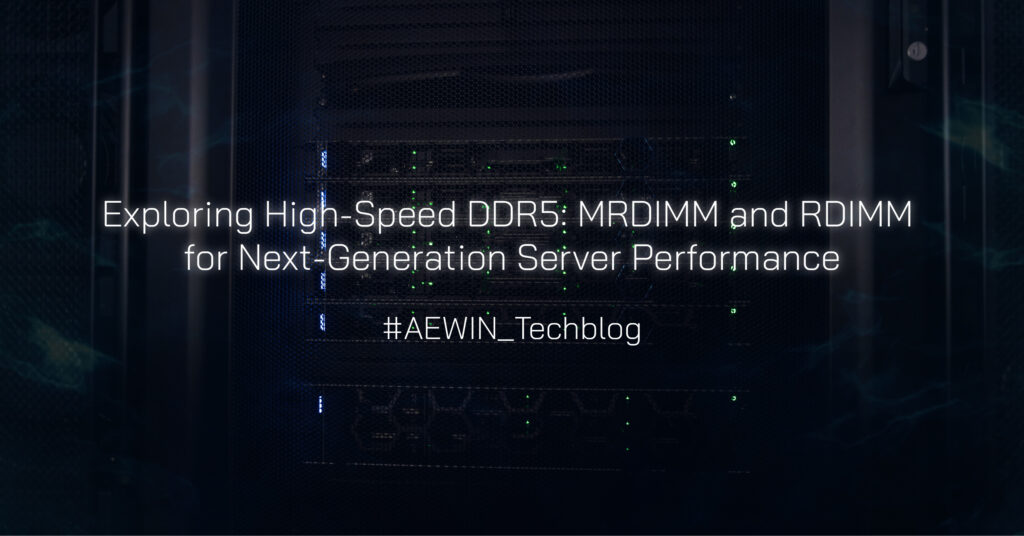
Introduction
DDR5 (Double Data Rate 5 Synchronous Dynamic Random-Access Memory) represents the latest advancement in DRAM technology, designed to meet the growing demand for higher bandwidth, capacity, and power efficiency in computing. Its development is led by the Joint Electron Device Engineering Council (JEDEC), the organization responsible for defining open standards for the microelectronics industry. JEDEC’s DDR5 specification, published in 2017, set new benchmarks for data rates, starting at 4800 MT/s and the first production is released in 2020.
High Speed DDR5
For server deployment, two of the key module types of DDR5 are RDIMM (Registered DIMM) and MRDIMM (Multiplexer Rank DIMM). Each offers distinct benefits, catering to different performance and scalability requirements.

*The increased speed of the next generation spec will have further discussion among JEDEC members to decide if it will upgrade to DDR6.
● RDIMM (Registered DIMM):RDIMMs are a widely adopted memory type in server environments, having a register to buffer and control signals for enhanced signal integrity. It is designed with on-board Power Management Integrate Circuits (PMIC) that help regulate the power required by DRAM, Register, SPD hub (Serial Presence Detect EEPROM), etc. For server-class modules, the PMIC operates at 12V to enhance power distribution compared to previous generations, improves signal integrity, and minimizes noise levels.

*The information is referenced from Micron Product Roadmap.
-Fast Speed: RDIMM modules for DDR5 currently operate up to 6400 MT/s depending on the memory and CPU selected.
-Increased Capacity: Supports up to 128 GB per module which has doubled compared to the previous generation, DDR4-64GB.
-Enhanced Power Efficiency: Operates at 1.1V, offering better power efficiency compared to DDR4’s 1.2V.
● MRDIMM/MCRDIMM:MRDIMM (Multiplexed Rank DIMM), first proposed by AMD and JEDEC, is an emerging technology designed to enable ultra-high-speed DDR5. MCRDIMM, Multiplexer Combined Ranks DIMM, is with similar design introduced by Intel and SK Hynix. By integrating a multiplexer that manages multiple DRAM ranks within the module, it allows higher data rates and larger capacities without significant trade-offs in power consumption or signal quality.
-Extreme Speed: Capable of achieving speeds up to 8800 MT/s, significantly surpassing RDIMM’s current limits.
-Large Capacity: Supports up to 256 GB per module, which makes MRDIMM/MCRDIMM ideal for memory-intensive applications.
-Excellent Power Efficiency: To Support higher speeds and capacities, the power efficiency is enhanced with advanced signal management.
Benefits of High-Speed DDR5 in Servers
The adoption of high-speed DDR5 memory, particularly in configurations using RDIMM and MRDIMM, provides several key advantages for servers:
– Increased Bandwidth: The higher data rates of DDR5, especially with MRDIMM, significantly enhance data throughput, crucial for AI, machine learning, deep learning, and data analytics workloads that require rapid access to large data sets.
– Enhanced Scalability: RDIMM offers great scalability for different use cases. MRDIMM’s higher capacity per module enables servers to scale up memory configurations and support larger in-memory databases for real-time applications.
– Improved Power Efficiency: DDR5’s lower operating voltage combined with RDIMM/’MRDIMM’s optimized signal management reduce overall power consumption, which lead to greener data center operations and lower TCO (Total Cost of Ownership).
– Better Reliability and Stability: RDIMM’s registered design and MRDIMM’s multiplexer approach provide robust signal handling, minimizing errors in high-speed and high-capacity environments.
Conclusion
The evolution of DDR memory marks a significant leap forward in server performance. RDIMM and MRDIMM of DDR5 offering solutions for varying needs. RDIMM provides a reliable choice for mainstream server applications, balancing speed and capacity. Meanwhile, MRDIMM features unmatched data rates and module capacities, pushing the boundaries for next generation solutions and driving advancements across AI, data analytics, and beyond.